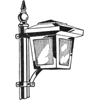
|
prismatic lantern
A prismatic refractor lantern for vertically mounted discharge lamps.
Available with lenticular prismatic panels of two types: one suitable for either wide
spacing, and one for close spacing in wide streets. It features self-contained
external shrouded wiring terminals. Can be supplied with brackets for pole or wall mounting.
|
|
???
|
250-400W MA/V
|
GES
|
Vertical clamp
|
No Gear
|
1936 Advert
|
|
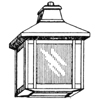
|
??? lantern
For mercury discharge lamps.
|
|
L1731
|
250-400W MA/V
|
GES
|
Top Entry
|
No Gear
|
1936 Advert
|
|
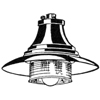
|
??? lantern
For filament lamps.
|
|
L1821
|
???W GLS
|
???
|
Top Entry
|
No Gear
|
1936 Advert
|
|
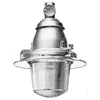
|
refrax Lantern
Introduced in 1938 after an extensive redesign of the Simplex Lantern range after the publication of the Final Report
by the MOT. Described as one of the most up-to-date lanterns of its type on the market. The single piece bowl refractor
complies with all the MOT requirements as regards lighting efficiency. The lantern is non-ventilated and can be used for long
periods without cleaning. The interior construction causes rapid circulation of air by convection to prevent condensation. Other
features are the positive focussing adjustment (which enables the lamp-holder to be set against a scale), a cool wiring
chamber with positive condensation-proof trap, and a ball socket aligner to enable the lantern to be used on tramway
poles or concrete poles which may be set out of the vertical. By 1939, an opal globe
was available for the new 400W MAF/V lamp. This type of fitting is particularly
suitable for towns where colour values are of importance and glare must be entirely
obviated. The bowl refractor was described as single-piece, dust-proof, non-axial
in 1939. Post-war it was described as one ofthe most highly developed dust-proof lanterns at present available and
this "finality" design would remain unaltered in its popularity as long as the vertical burning lamp is used
on traffic routes.
|
|
Refrax
|
400W MA/V
400W MAF/V
|
???
|
Top Entry
|
No Gear
|
1938 Advert
1939 Programme
1947 Programme
|
|
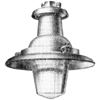
|
|
|
|
arteria lantern
Described as new in 1939. Designed to produce the maximum possible highway
illumination with the minimum running costs, therefore applicable to a long
length of arterial road with high density or fast moving traffic. They are fitted with
dust-proof refractors and anodized aluminium reflectors.
|
|
Arteria
|
140W SO/H
|
???
|
???
|
No Gear
|
1939 Programme
|
|
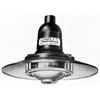
|
starlite lantern
Designed to BS/ARP 37. For wartime use. The fitting is unique as the whole of the optical assembly, sealed in a clear glass cylinder, can be detached for
relamping and reassembled in a few seconds. Outstanding features include: The candle-power and the shape of the polar curve
are controlled by selective absorptions of unbreakable, opaque metal parts, and are not dependent on the reflection or
transmission of white reflectors or opal glass; the whole of the optical assembly is absolutely dust and insect proof,
being sealed with a glass cylinder, with soft rubber gaskets; the use of a 15W lamp for all of the specified mounting
heights is afeature of this design; and a range of Simplex adaptors both rigid and flexbile are available for use
with the 1½" hole type fittings - these allow the Starlite fittings to be attached quickly and easily to
many existing lighting fittings without rewiring.
|
|
???
|
15W GLS
|
BC
|
Top Entry
|
No Gear
|
1940 Journal
|
|
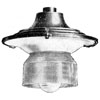
|
refractor lantern
For Group B lighting. Smaller open-type lantern for either filament or discharge lamps. Single and two-piece refractors.
Pre-set focussing adjustment.
|
|
???
|
60-200W GLS
80-125W MB/U
|
BC
3BC
|
Top Entry
|
No Gear
|
1947 Advert
|
|



